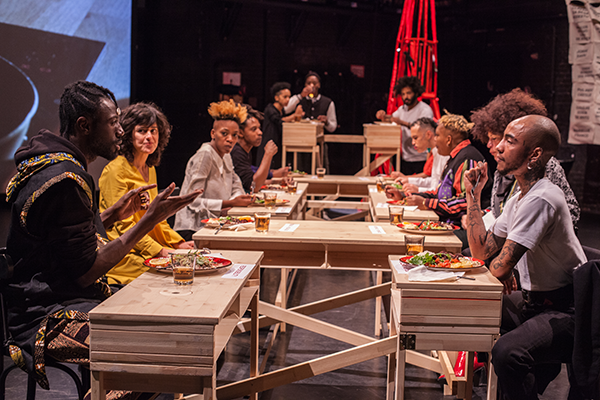New Collaboration between FFJ and MIMIMI Space #1: Brazilian Feijoada – performative and discursive common meal
Ricardo de Paula mimimeets Sandra Bello, Karina Griffith, Iury Trojaborg and Renata Motta, with dancers of CLEANSE/NU.
News from Nov 27, 2020
The Brazilian feijoada opens the journey of MIMIMI Space. Ricardo de Paula invites his guests for a banquet. By offering feijoada, a disputed symbol of Brazilian national cuisine and identity, Ricardo de Paula sets the stage (and the table) for discussions about the tensions behind narratives of harmony and the violent culture and everyday lives in Brazil. Commensality here is informed by shared concerns regarding anti-racism, food justice and body politics from a feminist and decolonial perspective. Renata Motta, Sandra Bello and dancers from CLEANSE/NU give artistic, scientific and activist impulses for an exchange among all attendants.

© Miro Wallner
The Brazilian feijoada was constructed as a symbol for the coming together of different peoples, African, European, and American Indigenous peoples, and the resulting cultural richness of Brazil - the origin of Ricardo de Paula and a large part of the MIMIMI team. No doubt that feijoada is a result from the exchange of peoples, cuisines and crops between world regions over the centuries. But just as any myth of a national identity, feijoada turns out to be a disputed symbol, permeated by inequalities between who has the power to define. Within a dominant discourse on Brazilian identity in which racial hierarchies are downplayed, the construction of feijoada as a national dish can be understood as a white project on closer inspection, as the often sketched image of the harmonious, multicultural Brazilian society does not correspond to its structural racism. Such national discourses invisibilize subaltern subjects and cultures. Como podemos decolonizar a feijoada? Black beans, key ingredients to the dish, have always been ritual food of black people, comida de santo. Afro-Brazilian religions, together with other symbols of Black cultures and memories, have been increasingly attacked by reactionary movements in the country. Historic, structural racism gains a renewed discursive momentum and finds new subjects to perpetuate it. Thus, reclaiming feijoada as black food and rejecting its association with myths of national, supposedly post-racial identities, can be also an anti-racist stance.

© Miro Wallner
Feijoada is also entangled in postcolonial relations of trade and ecologies. The expansion of cultivation of soybeans in Brazil in the last decades for e.g. European and Chinese animal farming has burned forests and displaed the cultivation of rice and beans, the everyday food of millions of Brazilians. Food became extremely expensive, especially in times of pandemics, with food insecurity rising. The current food price crisis in Brazil has structural roots and sheds light on the question: quem cuidou e manteve os feijões? While plantation economies have catered for foreign commodity markets, slave gardens, female-led household gardens, peasant and family farmers have been responsible for actually cultivating food. A further step of invisibility is the time involved in food preparation, as part of domestic work, often performed by black, poor, women. The MIMIMI-space wants to make care relations visible and feijoada offers good food for thought.

© Miro Wallner
This and other topics related to feijoada are the subject of discussion - in a common space that requires courage from all participants to question their own position. This is no safe space, but a brave space, in which there is no unquestioned “we”, but nevertheless, the host realizes his utopic wish to assemble people who are willing to eat and digest together the tensions and possibilities of building worlds otherwise. What do we eat, what do we have to digest and what do we no longer want to swallow? Feijoada is also a programme in another respect: with its long preparation time, it is a meal that stands for a different concept than today's trend towards fast food. This is the model for the artistic work of the project. The individual events are usually preceded by years of involvement of the participants with the respective themes, here they come together in a new way.
